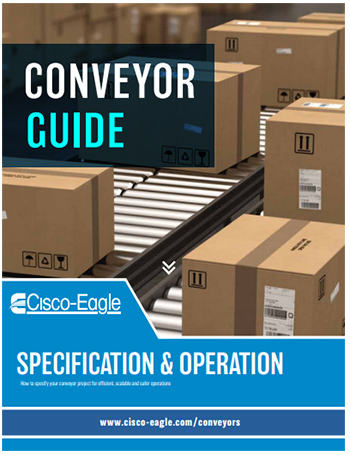How to Convey Large, Heavy Loads
A guide to conveying your heaviest items

The demand for high-throughput, accurate order fulfillment isn’t only about sorting cartons, parcels and other relatively small, light packages. Large, bulky, heavy items are also in high demand and must be quickly picked, sorted and shipped.
Many of today’s advanced sortation conveyor solutions are designed for parcel shipping. This is natural due to the increased demand for fast order fulfillment and e-commerce. A wide variety of sorters are ideal for diverting and transporting the kind of cartons or envelopes that end up on your front porch.
It’s not about handling large sizes or heavy weights. It’s about sorting them
On the other hand, conveying large, heavy loads like pallets and drums is easily accomplished with heavy roller systems and high-capacity conveyors. These types of conveyors are a safe and common way to transport everything from work in process, full pallet loads, progressive assembly and other heavy applications. Pipe, which is very long and heavy, is also relatively easy to convey with today’s technology. These heavier conveyors are mostly meant to convey in straight lines.
What about the need to sort and divert–particularly at speed?
Large parcels, the kind that contains furniture, components, bulk items or other heavyweight loads have been excluded from sortation operations in many industries due to the difficulties involved in sorting them. This reduces the efficiency of distributing these products because the default option often becomes manual handling with its labor-intensive and slower throughput rates. This often means multiple internal systems to do the same work.
Large item sortation factors
- They’re often heavy–hundreds of pounds.
- They can be oddly shaped, like tires, cartons, ladders and more.
- Sortation solutions must be able to handle both hefty loads, and smaller cartons, poly bags or envelopes.
- Many operations must be able to convey and divert large varieties of items.
- Solutions shouldn’t require separate lines or complex designs.
- Their dimensions can be challenging. Cartons can be 7 feet long, 3 feet tall and everything in between. The sorter must be able to divert a variety of sizes and shapes and dimensions.
- Diversion must be positive and gentle.
To achieve the same fast throughput that has been previously possible mostly for smaller, lighter loads, a new sorter design was needed.
The ProSort 1400 LP
The ProSort 1400LP sortation system meets these challenges with beefy divert blocks that are ideal for diverting larger, heavier items. This sorter can still deftly sort smaller items down to things as small as poly bags. The conveying surface is built from anodized aluminum slats with low-friction surfaces that help these larger items slide across and divert.
Large items often require the same fast throughput that smaller ones do, so this sorter was created to sort them at up to 350 feet per minute. For furniture and other heavy cartons, this higher throughput can be critical. It handles loads as small as 4″ x 6″ and as large as 6′ x 8′.
Example: Diverting a “jumbo” product: a 200-pound sofa in a box. Imagine sorting a carton about the size of an NBA center at speed. The LP can easily divert it as it moves through the process. This means that large, heavy cartons of almost any kind can be diverted.
Heavy, durable components are required
Because these heavier, bulkier products are more likely to damage the conveyor, it is critical that your sorter is built with easily-replaceable slats and shoes. Divert mechanisms must be not only robust; they must be easily accessed for maintenance, service and replacement when needed. Divert mechanisms smoothly and gently transition products to the sort position and off to their destinations with an integrated spur takeaway.
If a jam occurs, the divert shoes decouple from their base to help protect the sorter.
Heavy carton sortation
1400 LP diverts items ranging from a 126-pound box that’s 76″ long, 25″ wide and 9″ tall to a more concentrated load (a box 90 pounds, but only 49.5″ long). To showcase its versatility, it can also sort taller boxes, like a mattress box that is 19″ tall.
Diverting non-carton loads and products

These sorters divert non-carton loads, including many odd shapes and physical configurations.
- Tires: Ranging from 42″ semi truck tires that weigh over 105 pounds to stacks of smaller car tires.
- Drums: the 1400LP can gently divert tall drums without upsetting them or causing balance issues.
- Longer items: Extremely long items can cause issues for some sortation systems. The 1400 LP has diverted items ranging from 99″ long, 40-pound rolled rugs to 57″ long stepladders.
- Others: If you have a larger, non-standard load, we can help you design and test a sortation solution.
Because of its versatile design, this sorter handles multiple kinds of items of various dimensions: everything from tire bundles to drums to cartons to envelopes. This is critical for distribution operations that require multi-functional sort lines that accommodate a large variety of loads, sizes, weights and configurations.
Versatility is key
If you’re conveying a mix of smaller, lighter loads alongside a variety of larger, heavier ones, a sortation strategy that handles both is the most efficient way. Using new technologies and today’s more advanced automation concepts can help you reduce operational inefficiencies.
Download Cisco-Eagle’s guide to conveyors & systems
Well-executed conveyors and systems will optimize your operation–and we can help you make that happen. Cisco-Eagle’s detailed guide to conveyors gives you advice from our expert employee-owners, links, articles and more.
Download the guide today
Scott Stone is Cisco-Eagle's Vice President of Marketing with 35 years of experience in material handling, warehousing and industrial operations. His work is published in multiple industry journals an websites on a variety of warehousing topics. He writes about automation, warehousing, safety, manufacturing and other areas of concern for industrial operations and those who operate them.




